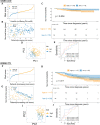The DDR-related gene signature with cell cycle checkpoint function predicts prognosis, immune activity, and chemoradiotherapy response in lung adenocarcinoma
- PMID: 35840978
- PMCID: PMC9288070
- DOI: 10.1186/s12931-022-02110-w
The DDR-related gene signature with cell cycle checkpoint function predicts prognosis, immune activity, and chemoradiotherapy response in lung adenocarcinoma
Abstract
Background: As a DNA surveillance mechanism, cell cycle checkpoint has recently been discovered to be closely associated with lung adenocarcinoma (LUAD) prognosis. It is also an essential link in the process of DNA damage repair (DDR) that confers resistance to radiotherapy. Whether genes that have both functions play a more crucial role in LUAD prognosis remains unclear.
Methods: In this study, DDR-related genes with cell cycle checkpoint function (DCGs) were selected to investigate their effects on the prognosis of LUAD. The TCGA-LUAD cohort and two GEO external validation cohorts (GSE31210 and GSE42171) were performed to construct a prognosis model based on the least absolute shrinkage and selection operator (LASSO) regression. Patients were divided into high-risk and low-risk groups based on the model. Subsequently, the multivariate COX regression was used to construct a prognostic nomogram. The ssGSEA, CIBERSORT algorithm, TIMER tool, CMap database, and IC50 of chemotherapeutic agents were used to analyze immune activity and responsiveness to chemoradiotherapy.
Results: 4 DCGs were selected as prognostic signatures, and patients in the high-risk group had a lower overall survival (OS). The lower infiltration levels of immune cells and the higher expression levels of immune checkpoints appeared in the high-risk group. The damage repair pathways were upregulated, and chemotherapeutic agent sensitivity was poor in the high-risk group.
Conclusions: The 4-DCGs signature prognosis model we constructed could predict the survival rate, immune activity, and chemoradiotherapy responsiveness of LUAD patients.
Keywords: Cancer prognosis; Cell cycle checkpoint; DNA damage repair; Gene signature; Lung adenocarcinoma.
© 2022. The Author(s).
Conflict of interest statement
The authors declare that they have no conflict of interest.
Figures











Similar articles
-
An ICD-Associated DAMP Gene signature predicts survival and immunotherapy response of patients with lung adenocarcinoma.Respir Res. 2023 May 31;24(1):142. doi: 10.1186/s12931-023-02443-0. Respir Res. 2023. PMID: 37259066 Free PMC article.
-
Construction and Validation of a Tumor Microenvironment-Based Scoring System to Evaluate Prognosis and Response to Immune Checkpoint Inhibitor Therapy in Lung Adenocarcinoma Patients.Genes (Basel). 2022 May 26;13(6):951. doi: 10.3390/genes13060951. Genes (Basel). 2022. PMID: 35741714 Free PMC article.
-
Identification of immune activation-related gene signature for predicting prognosis and immunotherapy efficacy in lung adenocarcinoma.Front Immunol. 2023 Jul 7;14:1217590. doi: 10.3389/fimmu.2023.1217590. eCollection 2023. Front Immunol. 2023. PMID: 37492563 Free PMC article.
-
Leveraging diverse cell-death patterns to predict the clinical outcome of immune checkpoint therapy in lung adenocarcinoma: Based on muti-omics analysis and vitro assay.Oncol Res. 2023 Dec 28;32(2):393-407. doi: 10.32604/or.2023.031134. eCollection 2023. Oncol Res. 2023. PMID: 38186574 Free PMC article.
-
Comprehensive analysis identifies DNA damage repair-related gene HCLS1 associated with good prognosis in lung adenocarcinoma.Transl Cancer Res. 2023 Oct 31;12(10):2613-2628. doi: 10.21037/tcr-23-921. Epub 2023 Oct 24. Transl Cancer Res. 2023. PMID: 37969376 Free PMC article.
Cited by
-
Development and validation of a novel DNA damage repair-related long non-coding RNA signature in predicting prognosis, immunity, and drug sensitivity in uterine corpus endometrial carcinoma.Comput Struct Biotechnol J. 2023 Oct 14;21:4944-4959. doi: 10.1016/j.csbj.2023.10.025. eCollection 2023. Comput Struct Biotechnol J. 2023. PMID: 37876625 Free PMC article.
-
Prognostic significance and immune landscape of a cell cycle progression-related risk model in bladder cancer.Discov Oncol. 2024 May 12;15(1):160. doi: 10.1007/s12672-024-01008-x. Discov Oncol. 2024. PMID: 38735911 Free PMC article.
-
PANoptosis-related long non-coding RNA signature to predict the prognosis and immune landscapes of pancreatic adenocarcinoma.Biochem Biophys Rep. 2023 Dec 7;37:101600. doi: 10.1016/j.bbrep.2023.101600. eCollection 2024 Mar. Biochem Biophys Rep. 2023. PMID: 38371527 Free PMC article.
-
LINC00669 promotes lung adenocarcinoma growth by stimulating the Wnt/β-catenin signaling pathway.Cancer Med. 2023 Apr;12(7):9005-9023. doi: 10.1002/cam4.5604. Epub 2023 Jan 9. Cancer Med. 2023. PMID: 36621836 Free PMC article.
-
Identification of a Novel Gene Signature with DDR and EMT Difunctionalities for Predicting Prognosis, Immune Activity, and Drug Response in Breast Cancer.Int J Environ Res Public Health. 2023 Jan 10;20(2):1221. doi: 10.3390/ijerph20021221. Int J Environ Res Public Health. 2023. PMID: 36673982 Free PMC article.
References
-
- Global Burden of Disease Cancer C. Kocarnik JM, Compton K, Dean FE, Fu W, Gaw BL, Harvey JD, Henrikson HJ, Lu D, Pennini A, et al. Cancer incidence, mortality, years of life lost, years lived with disability, and disability-adjusted life years for 29 cancer groups from 2010 to 2019: a systematic analysis for the Global Burden of Disease Study 2019. JAMA Oncol. 2022;8:420–444. doi: 10.1001/jamaoncol.2021.6987. - DOI - PMC - PubMed
MeSH terms
Grants and funding
LinkOut - more resources
Full Text Sources
Medical
Research Materials

